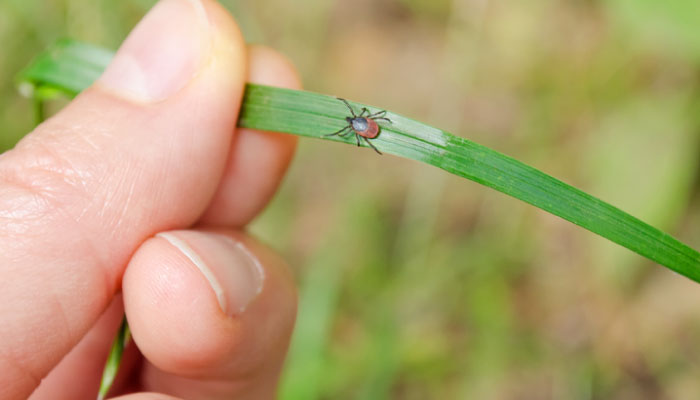Posted on: May 20, 2020
Is it a coincidence that the grossed-out term “ick” is within the word “tick”? Probably not.
Ticks are tiny, stealthy, always looking for a ride on a warm-blooded host, and sometimes transmit disease. They want your blood and they don’t want you to know they’re drinking it. Ick!
An adult tick is about the size of a sesame seed. Yet, even smaller, immature ticks (nymphs) can transmit disease while drinking your blood.
Where and when are ticks most active?
Ticks carrying Lyme and other diseases are found throughout the U.S. and world. Even in areas not known for Lyme disease, keep in mind that people, pets, and ticks travel, creating opportunities for exposure in both rural areas and cities.
Ticks often lurk near stone walls, in tall grass, leaf litter, and in brushy and wooded areas (especially the woodland edge). They can be active anytime above freezing, but they are especially active in March through mid-May and mid-August through September. However, June and July are the peak months for reported tick bites.
These opportunistic blood-suckers usually hitch a ride on your clothes as you walk by, climb up your boots and pants, and slowly and methodically make their way inside your clothes to attach to your skin. You usually can’t feel them walking on you, or even biting. They can bite you anywhere, but especially like feeding on soft skin, such as the stomach or behind the ears, or moist areas, such as the groin (ugh).
Many people don’t remember being bitten.

Enjoying this article?
Subscribe + don’t miss the next one!
We’ll also send you our e-book: Live Younger 25 Ways to Age Gracefully—Starting Now.
What diseases can ticks transmit?
Lyme, the most common tick-borne disease, is caused by the bacterium Borrelia burgdorferi, primarily carried by black-legged ticks, also called deer ticks.1The Centers for Disease Control estimates that more than 300,000 new cases of Lyme disease occur each year in the U.S. Your chances of being infected are higher the longer the tick has been feeding (attached).
Antibiotics are used as treatment against Lyme. The problem is that patients sometimes relapse after treatment ends. Why?
It could be because Ehrlichia, Anaplasma, Babesia, Rocky Mountain Spotted Fever, Powassan, and possibly Bartonella can also be transmitted by a tick bite. Infections involving multiple pathogens can be more difficult to diagnose and treat.
In short, ticks may carry lots of nasty infectious organisms that can cause devastating symptoms.
What are some of the signs and symptoms of Lyme?
If you are alert to the early signs, common symptoms include:

- “Bull’s-eye” rash
- Fever
- Headache
- Fatigue
- Muscle and joint pain
The non-rash symptoms are often described as “summertime flu”. Some people may notice areas of numbness or tingling.
Once the infection spreads beyond the skin, it can affect any system of the body causing many symptoms, including:
- Debilitating fatigue
- Headaches
- Muscle pain
- Arthritis
- Numbness
- Tingling
- Nerve pain and weakness
- Heart problems
- Psychiatric symptoms: anxiety, depression, irritability, psychosis, and more
- Difficulty with thinking, memory, language, and math skills
- Sleep disturbance
- Problems with vision and hearing
How can we avoid/repel ticks?
As always, your best defense is to keep your immune system strong. And use common sense when venturing in nature:
- Keep your lawn cut short.
- Keep a barrier of wood chips between your lawn and brushy, wooded areas.
- Wear light colored clothes when hiking so you can see ticks better.
- Tuck your pants legs into your socks to make it harder for ticks to get to your skin.
- Wear a hat to keep your hair tucked in. Before going inside, inspect your clothes and hair.
- Right after hiking, tumble clothes in a hot dryer for 60 minutes.
- Inspect your body (using a hand-held mirror), paying close attention to your hairline, behind your ears, armpits, and groin.
- Shower after hiking to remove any ticks or nymphs that may not have attached yet.

As for repelling the little buggers, natural compounds found in coconut oil2 have proven to be longer-lasting, and safer repellents than DEET, long thought to be the most effective (yet which carries troubling health risks) pharmaceutical insect repellent.
Other tested natural insect repellents include (diluted) essential oils from clove, oregano, vetiver, and garlic.3
How to Remove a Tick
If you find an attached tick, first of all, don’t panic.4 Not every single tick is infectious. Perhaps this tick carries no disease, or perhaps it hasn’t been feeding long enough.
But you must be cautious, just in case.
- Do not use nail polish, petroleum jelly, a burnt match on the tick’s backside, or any other home remedy you may have heard.
- Do not squeeze the tick’s body with your fingers or regular eyebrow tweezers. If you do, the tick is more likely to regurgitate toxins into its host, making it potentially more infectious.
- Use special, tiny-tonged tweezers, if possible. If not, use a thread to tie around the tick’s head, as close to the skin as possible.
- With special tweezers or thread, gently pull the tick straight out. Do not try to twist or “unscrew” the head. Just pull it straight out. You want to remove the head and mouthparts.
- Save the tick in a jar of alcohol or in a baggie in the freezer for later testing, if necessary.
- Wash the bite area and your hands well with soap and water.
Early Diagnosis Leads to Better Outcomes
Lyme and other tick-borne diseases can lead to serious consequences (even death) if left untreated. If you (or a friend or family member) develop symptoms and suspect a tick bite as the cause, take immediate action.
Please be aware that not every doctor is experienced in successfully treating tick-borne diseases.
Prevention and early diagnosis are essential!
How can I tell if I have Lyme disease from a tick bite?
Lyme disease should be clinically diagnosed. A medical professional must evaluate your symptoms, physical findings, exposure risk, and any test results to determine whether you have the disease. No single factor or test result is enough to determine whether you do or do not have Lyme or other tick-borne illnesses.
If bitten by a tick, should I consider immediate antibiotics to prevent Lyme disease?
The International Lyme and Associated Diseases Society5 (ILADS) recommends that prophylaxis (preventive treatment) be discussed with all who have had a black-legged tick bite. An appropriate course of antibiotics has been shown to prevent the onset of infection (provided there are no contraindications).
The decision to treat a black-legged tick bite with antibiotics often depends on where in the country the bite occurred, whether there was evidence that the tick had begun feeding and the age of the person who was bitten. Based on the available evidence, and provided that it is safe to do so, ILADS recommends a 20-day course of doxycycline (provided there are no contraindications).
Patients should also know that although doxycycline can prevent cases of Lyme disease, ticks in some areas carry multiple pathogens, some of which, including Babesia, Powassan virus, and Bartonella, are not responsive to doxycycline. This means a person could contract a tick-borne illness despite receiving antibiotic prophylaxis for their known tick bite.
Why do I find so much contradictory “expert” information about Lyme disease?
Lyme disease, perhaps taken more seriously when called Lyme borreliosis, is a multi-system infection, which can produce multiple symptoms that can mimic other illnesses.
In its earliest, localized presentation as an Erythema migrans (EM rash), Lyme is most easily recognized and successfully treated. When untreated or undertreated, it can spread to many parts of the body, and become far more challenging to diagnose and treat.
Expert information confusion arises from:
- Lab testing for Lyme has been challenging, with inconsistent accuracy and reliability.
- Medical providers often differ in their long-term management of persistent Lyme symptoms.
- Because we have now found Lyme cases in a much wider range of locations than previously thought probable, many providers are unfamiliar with its signs and symptoms.
- Co-infections (one tick delivering more than one type of infection) complicate patient care.
- When science is incomplete, disagreement among healthcare providers is common.
Enjoying this article? Subscribe + don’t miss the next one!
We’ll also send you our e-book: Live Younger 25 Ways to Age Gracefully—Starting Now.
As always, in emerging illnesses, there is always more to learn. Trust your health to a doctor who has been ILADS-trained in the most up-to-date knowledge in Lyme.
I know, from firsthand experience, what it’s like to face a challenging, complex, environmental illness. That’s why I studied, trained, and became certified with ILADS. So that I could help my patients.
Why wonder if a tick bite may be the cause of your symptoms?
Contact me now to book an appointment.
Even complex health challenges, like tick-borne disease, can be overcome with expert care.

